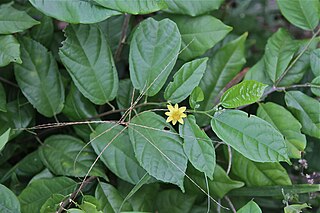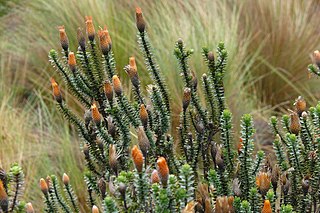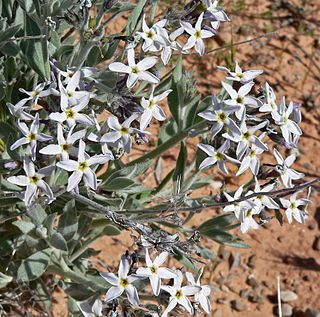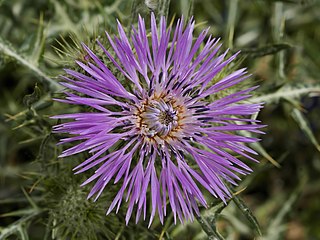
Stranvaesia is a genus of flowering plants in the family Rosaceae. Its morphology is so similar to Photinia that it has sometimes been included within that genus, but recent molecular data indicate that the two genera are not related.

Goupia is a neotropical genus of flowering plants and the sole genus included in the family Goupiaceae. There are three species, all found in tropical northern South America.

Charpentiera is a flowering plant genus in the family Amaranthaceae. It consists of five species endemic to Hawaiʻi, where they are known as pāpala, and one species found only on the island of Tubuai in the Austral Islands. All species are trees, some reaching more than 10 metres (33 ft) in height. The genus is named for Arsène Charpentier (1781-1818), professor of pharmacy at Antwerp from 1810 to 1814 and at Cherbourg from 1814 to 1816.

Psychotria is a genus of flowering plants in the family Rubiaceae. It contains 1,582 species and is therefore one of the largest genera of flowering plants. The genus has a pantropical distribution and members of the genus are small understorey trees in tropical forests. Some species are endangered or facing extinction due to deforestation, especially species of central Africa and the Pacific.

Sesbania tomentosa, commonly known as Oahu riverhemp and ʻŌhai, is an endangered species of flowering plant in the pea family, Fabaceae, that is endemic to the main Hawaiian Islands as well as Nihoa and Necker Island. It inhabits low shrublands and, rarely, dry forests, at elevations from sea level to 2,500 ft (760 m). Associated native plant species include akiʻaki, ilima, naupaka kahakai, and pili. Off-road vehicles, wildfires, grazing, and alien species competition have destroyed their habitat on the main islands, but they are still quite common on Nihoa and Necker. At least 2000 specimens grow on Nihoa, while there are far less on Necker.
Delonix tomentosa is a species of flowering plant in the family Fabaceae. It is endemic to Madagascar, where it is known only from the type specimen collected over 100 years ago. It has not been seen since and may be extinct.

Glyphaea is a genus of African flowering plants in the family Malvaceae, subfamily Grewioideae; it was previously placed in the Tiliaceae or Sparrmanniaceae.

Chuquiraga is a genus of flowering plants in the aster family. The genus is distributed in the Andes from Colombia to Chile, with most species occurring in Patagonia.
Pentzia tomentosa is a species of flowering plant in the aster family. It is endemic to Namibia. Its natural habitat is rocky areas.
Basselinia tomentosa is a species of flowering plant in the family Arecaceae. It is found only in New Caledonia.

Tilia tomentosa, known as silver linden in the US and silver lime in the UK, is a species of flowering plant in the family Malvaceae, native to southeastern Europe and southwestern Asia, from Romania and the Balkans east to western Turkey, occurring at moderate altitudes.

Amsonia tomentosa is a species of flowering plant native to the southwestern United States and northern Mexico (Chihuahua). Its common names include woolly bluestar and gray amsonia.

Sorbaria is a genus of around four species of flowering plants belonging to the family Rosaceae.
Stranvaesia tomentosa is a species in the family Rosaceae of flowering plants.
Fulcaldea is a genus of flowering plants in the daisy family.

Galactites is a genus of flowering plants in the thistle family. The name is derived from the Greek γάλα. The best known species is Galactites tomentosa.

Hudsonia tomentosa is a species of flowering plant in the rockrose family known by the common names woolly beachheather, beach heather, and sand heather. It is native to northeastern North America, including central and eastern Canada and the northeastern United States.

Packera tomentosa is a species of flowering plant in the composite family known by the common name woolly ragwort. It is native to the Southeastern United States, primarily to the coastal plain but extending into some areas inland. Its preferred habitat is open, sandy areas and granitic outcrops. It is common throughout its range.

Eriocapitella tomentosa, a species of flowering plant in the buttercup family Ranunculaceae, is native to Asia. The specific epithet tomentosa means "thickly matted with hairs, tomentum (padding)". In Chinese, a common name is da huo cao, which means "fire grass" or "fireweed".

Sorbaria tomentosa, the Himalayan sorbaria or Kashmir false spirea, is a species of flowering plant in the family Rosaceae. It is native to Afghanistan, Central Asia and the Himalayas, and has been introduced to the South Island of New Zealand. It has gone extinct in Tajikistan. Its putative variety Sorbaria tomentosa var. angustifolia, the narrow-leaved Himalayan sorbaria, has gained the Royal Horticultural Society's Award of Garden Merit.















